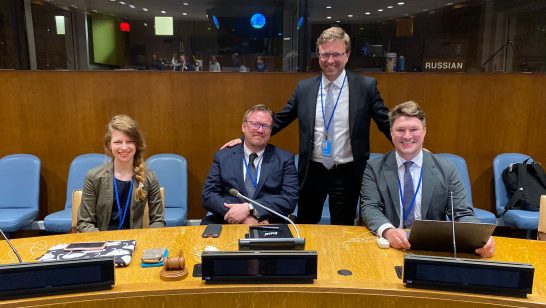
The atomic bombings of Hiroshima and Nagasaki in 1945 were the starting point of two contradictory thoughts on nuclear weapons. One is that nuclear weapons, given that they cause catastrophic consequences, should never be used again, and must be eliminated as soon as possible. The other is that just because of their destructive power, nuclear weapons serve as the most effective means for deterring nuclear as well as other major wars between the big powers and are one of the most significant sources of power in the anarchical international system.
Japan, wedged between such contradictory thoughts, has been struggling to construct policies on nuclear weapons issues. Needless to say, the experiences of Hiroshima and Nagasaki make Japan and the Japanese people understand the inhumanity of nuclear weapons better than any other country. That is why Tokyo has upheld the three non-nuclear principles and sought a world without nuclear weapons. At the same time, Japan has depended, in its security policy, on U.S. extended deterrence, including the nuclear umbrella, and explored how to maintain and enhance its credibility.
Those who advocate normative/legal approaches to the nuclear question sharply criticise Japan’s policy as an inconsistent one. They note that Tokyo has not had a particularly proactive attitude to the initiative on the humanitarian consequences of nuclear weapons, which aims to a prompt commencement of efforts for a nuclear weapons convention. However, it should not be underestimated how Japan has been struggling with the two contradictory thoughts outlined above. Furthermore, Tokyo cannot base its security policy solely on normative/legal approaches, since it is located in one of the focal regions of the global power transition, characterised by a destabilising and unpredictable security environment and deterioration of relationships among the major powers involved in a deepening geopolitical competition.
In such regions, including Asia and Europe, both revisionist and status quo countries have attempted to maintain and/or strengthen nuclear deterrence, and to reaffirm the value of nuclear weapons. On the one hand, for revisionist states seeking to reconfigure the existing international order or expand their spheres of influence, nuclear weapons are considered as one of the most significant assets for demonstrating their power, explicitly or implicitly. On the other hand, for the status quo states challenged by revisionist states, there are few alternatives but to respond to the latter’s assertiveness as well as emphasis on nuclear weapons through engaging in the power struggle over the shape of international/regional order and to re-affirm or enhance a reliability of nuclear deterrence.
In such security circumstances, one can hardly expect the nuclear-weapon states (NWS) to willingly accept radical nuclear disarmament in accordance with a normative/legal approach. NWS — and, to a lesser extent, the so-called “nuclear umbrella states” — are cautious about the possibility of decreasing their power by accepting a reduction of their nuclear deterrent capabilities.
To narrow the gap between the two contradictory lines of thought, Japan must embark on a difficult and bumpy path in search of a realistic agenda. Normative/legal approaches are essential for reframing the nuclear disarmament debate and achieving a world without nuclear weapons, especially in a medium to long-term perspective. Nuclear disarmament would also play an essential role in reinforcing the stability of the international system. Just emphasising and relying on nuclear deterrence could incur further destabilisation, and increase the possibility of the use of nuclear weapons. However, we cannot forget the fact that nuclear disarmament itself has been often regarded as a part of the power struggle. It is also clear that normative/legal approaches could hardly play an effective role in tackling the root causes of the current deadlock in nuclear disarmament.
The urgent task in these difficult times is to pursue realistic and practical arms control tailored to the security environment in key regions. The aim should be to prevent further exacerbation of the existing tensions thus buying time for future progress. Northeast Asia is one of the regions where such arms control should be explored as the utmost priority. In the past, because of the relatively stable regional security situation under U.S. dominance, few regional arms control efforts had been undertaken by the countries involved in security affairs in this region, except for the Six-Party Talks on North Korea’s nuclear weapons program. However, the regional security landscape has been dramatically changing: U.S. power is in relative decline; a rising China has aggressively pursued the modernisation of its military, including its nuclear and missile forces, and become more assertive, particularly in the South China and East China Seas. Russia’s annexation of Crimea, which clearly constitutes a violation of the 1994 Budapest Memorandum, undermined the overall credibility of the NWS commitments on security assurances.
The first step that should be taken by the countries concerned is to commence dialogues on perceptions of the functions of nuclear weapons in the current geostrategic competition, and on the role of nuclear arms control in managing crises, mitigating tensions, improving relationships among the countries concerned and maintaining order in relevant regions. It is also worthwhile to promote multiple confidence-building measures (CBMs) on nuclear weapons, missiles and other strategic issues.
In addition, the leading players could implement regionally some practical and realistic measures proposed by the Nonproliferation and Disarmament Initiative (NPDI), a coalition comprising 12 non-nuclear-weapon states, initiated by Japan and Australia, at the 2015 NPT Review Conference. These include: transparency of information relating to nuclear weapons (and preferably other weapons that have strategic implications, such as missiles, missile defence, and hypersonic strike capabilities); reductions of — or at least suspensions of enhancements to — nuclear and missile forces; revisions to the deployment postures of non-strategic nuclear weapons; reductions in the roles of nuclear forces; and visits to Hiroshima and Nagasaki by the people and leaders of leading countries.
A part of the arguments in this article were firstly appeared in Hirofumi Tosaki, “Nuclear Arms Control after the NPT Review Conference: The Need for a Realistic Approach in the Face of Geopolitical Competition,” AJISS Commentary, No. 213 (23 June 2015), http://www2.jiia.or.jp/en_commentary/201506/23-1.html.
The opinions articulated above represent the views of the author(s), and do not necessarily reflect the position of the European Leadership Network or any of its members. The ELN’s aim is to encourage debates that will help develop Europe’s capacity to address the pressing foreign, defence, and security challenges of our time.



